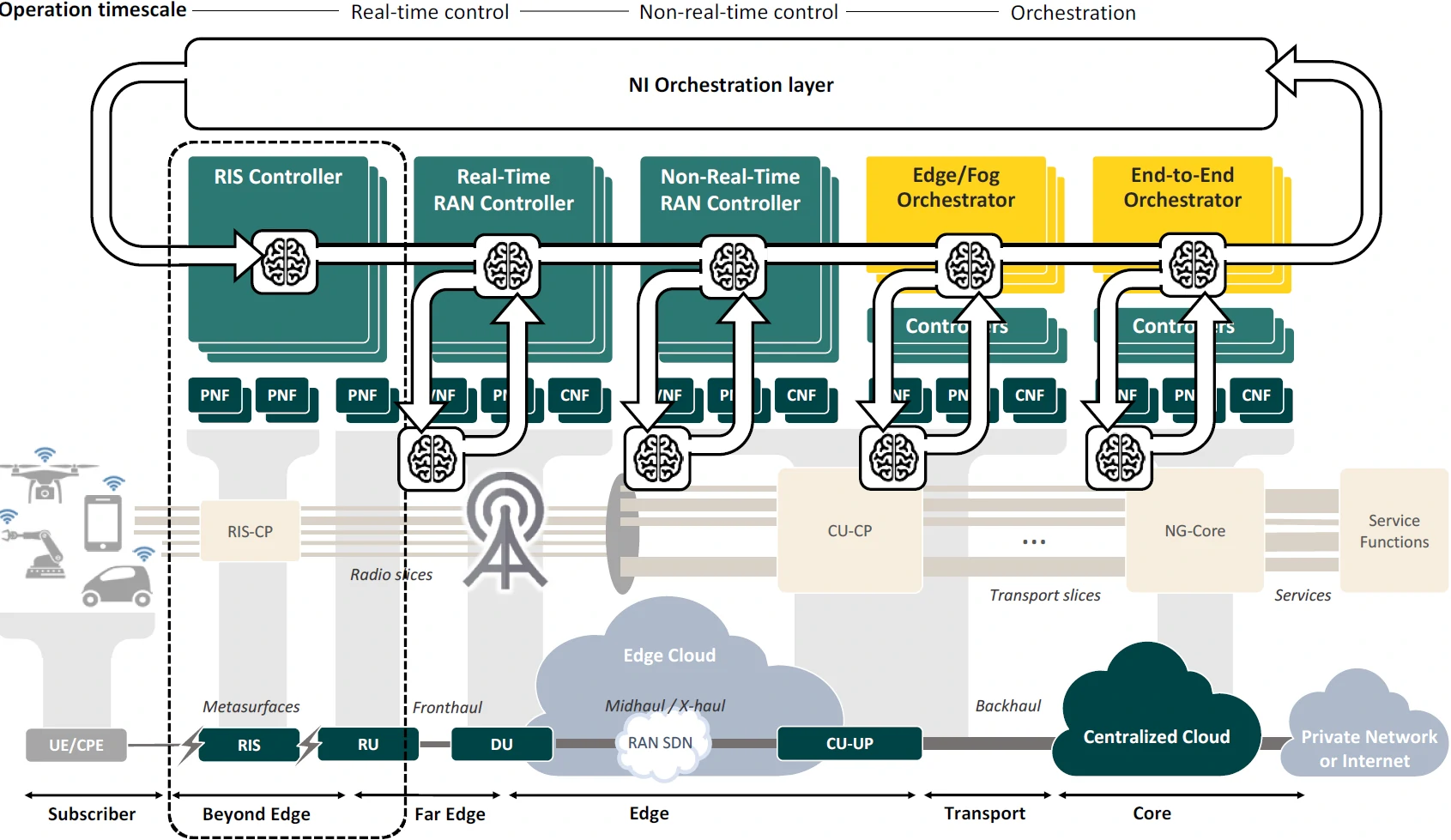Overview
Throughout and beyond their fifth generation, mobile networks will undergo an architectural revolution, aimed at supporting the extreme requirements set by future services that will assume performance indicators like virtually infinite capacity or perceived zero latency.
The mobile network architecture is being redesigned for end-to-end softwarization and cloudification, while the atomization of the classical access-core dichotomy is paving the road for network microdomains.
Fundamental to the optimal operation of the softwarized, cloudified and atomized network infrastructure will be the Network Intelligence (NI) responsible for managing the composite mosaic of network functions and associated resources in presence of a surging mass of services, tenants and slices.
Present trends in NI for next-generation network orchestration that are promoted by major standardization bodies pivot on the notion of closed-loop Artificial Intelligence.

The three levels of NI operation timescales are set apart by shaded areas that encompass the network entities belonging to each level; DAEMON brings pervasive intelligence into the real-time control domain of the network infrastructure, all the way within VNFs. The additional Beyond Edge micro-domain introduced by DAEMON and its associated entities are highlighted by the dashed line. The novel NI Orchestration layer introduces feedback loops across NI instances deployed throughout the network, including the new ones implemented at VNF level.
The DAEMON NI-native architecture introduces intelligence directly into the user plane, creating a hierarchy of NI instances for network management that removes the restrictions of closed-loop models. As illustrated, the project concept identifies three levels of NI, depending on their operation timescale:
- NI at Orchestrators.
- NI at Non-Real-Time Controllers.
- NI at Real-Time Controllers.
DAEMON goes beyond the vision of current standardization bodies, and pushes NI within Virtual Network Functions (VNFs) in the Far Edge, Edge, Transport and Core micro-domains, as well as in a novel Beyond Edge micro-domain. The architectural changes above forward a much deeper integration of intelligence in Beyond 5G (B5G) systems, and create a considerably wider ecosystem of NI instances that populate the network infrastructure both in the control and data planes.
As an inherent part of its proposed NI-native architecture, DAEMON sets out a structured approach to system-wide NI coordination by introducing an original NI Orchestration layer:
- Selecting the best NI algorithm to be run within each NI instance from a predefined range of options.
- Coordinating all NI instances in the system to ensure gracious operation of all live mechanisms operating at different timescales and in different micro-domains.
By implementing the tasks above, the NI Orchestration layer establishes and control a rich and organized set of feedback links between the NI at orchestrators, controllers, and VNFs.
In order to demonstrate the viability and benefits of its more structured NI architecture, DAEMON will develop a broad set of NI-assisted functionalities that cover all micro-domains and operation timescales envisioned by the proposed architecture.
Reconfigurable Intelligent Surfaces (RIS) are a very promising technology to enhance radio access performance towards the ambitious targets of B5G.
Edge environments present unique characteristics that make current Cloud-based management techniques hard to apply or highly inefficient, regardless of their underlying approach.
DAEMON will advance current solutions for the management of resources at the Edge, by designing dedicated NI algorithms that implement a holistic orchestration approach where diverse Edge functionalities are operated at different timescales and locations, whilst acting as a single integrated system via a multi-timescale loop.
Network programmability is a cornerstone of 5G architectures. Hence, DAEMON will design NI algorithms that leverage the novel computing fabric of the backhaul to support faster service provisioning.
Radio Access Network virtualization (vRAN) is regarded as a key technology to achieve high efficiency and reduced OPEX in B5G systems. DAEMON will design and implement NI-assisted solutions for vRAN radio resource scheduling.
The sustainability of B5G networks will heavily depend on the capability of orchestration and control frameworks at the Edge and Core to account for energy consumption figures when taking resource management decisions. the DAEMON NI-native architecture is the ideal milieu to implement a coordinated intelligence that optimally deploys VNFs according to their complex energy footprints.
Optimizing the utilization of resources across network micro-domains is vital to the reliable operation of B5G systems characterized by a very high degree of multi-tenancy, where strong service guarantees force isolating resources to slices. the partners of DAEMON are spearheading research on capacity forecasting models that anticipate the optimal amount of resources to be allocated to network entities at each reconfiguration opportunity
Anomalies in the network operation due to misconfigurations, malfunctions, or malicious behaviors risk to represent a particularly serious complication in B5G systems whose management will be already characterized by substantial added complexity with respect to 5G infrastructures. On top of the baseline anomaly detection functionalities, DAEMON will ensure that the dedicated NI addresses the whole lifecycle of the anomaly management process, and takes care of subsequent root cause analysis and automated response.
DAEMON aims at revolutionizing these practices, by bringing forward a number of fundamental contributions in establishing better and more appropriate techniques for the design of NI, where the AI hype is causing the overuse of DNNs as a “one-tool-fits-all” solution to any NI task.
DAEMON advocates for a more pragmatic approach to the integration of AI into networking environments, by proposing and promoting AI models for NI only where they actually make a difference. DAEMON gives full consideration to overlooked hybrid approaches that combine, e.g., statistical and DL models, following the path recently open by seminal results in the machine learning community.
DAEMON goes beyond state-of-the-art available models offered by the machine learning community, and seeks major contributions on how such models can be specifically tailored to the networking context. DAEMON will investigate techniques to solve the loss-metric mismatch for NI design, along two directions.
- The project will study the design of original loss functions that are based on expert knowledge.
- The project will build on recent advances in machine learning for the automated solution of the lossmetric mismatch, by means of an active bridge that continuously receives feedback about the relevant service
metrics.
Accuracy is the dominant criterion used to assess the quality of AI models, under any task. DAEMON will address the inherent shortcomings of AI for NI, by devising models that allow controlling the NI accuracy-cost trade-offs, and that support resilience and explainability by-design:
- The project will carry out seminal investigations of the accuracy-cost trade-offs offered by AI models by leveraging:
- Neural Architecture Search (NAS) methods.
- Natural uncertainty of AI models.
- The project will conduct pioneering research on the design AI models that can support NI under strict network resilience and interpretability specifications.


